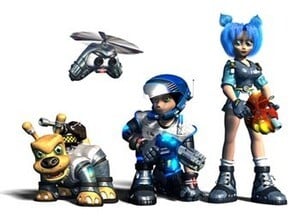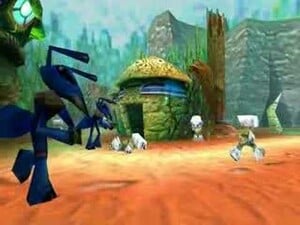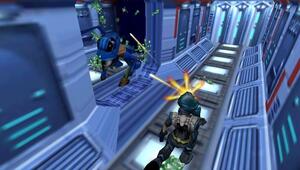
One of the most refreshing aspects of Jet Force Gemini was the way in which the player’s progression throughout the various levels was handled; initially, the only character available is Juno, but eventually other heroes are added to the roster, each faced with a slightly different route through the game world. “The characters all had an ability that was unique to them,” explains Lead Programmer Paul Mountain. “These were play-tested and fine-tuned against specific parts of the environment, which we developed to take advantage of one of the abilities. This enabled certain ‘forks in the road’ to be introduced into the game where 2 characters would be forced to go in one direction but the third would have the option – providing they recognised the opportunity – to take a different route. For example, Vela was able to swim under the water, so she could negotiate areas like underwater tunnels while Lupus was able to hover for short periods of time, giving him the ability to cross wide gaps that couldn’t be jumped. This introduced challenges into the level layout and timing of game events, such as the points where you unlocked or upgraded characters. These were resolved with a mixture of forward-planning and extensive play-testing.”
While the game was pushing the boundaries of what as possible in an N64 action title, it also displayed some of Rare’s famous experimentation – namely some brilliant racing mini-games. “We were initially trialling the introduction of a small hover ship,” says Mountain. ”This proved to be quite fun to fly around in so we wanted to do a bit more with it than simply hover about a few levels. Several members of the team - myself included - loved racing games and had worked on Diddy Kong Racing, so we knocked together some tracks and basic race mechanics to amuse ourselves with. Because these proved to be fun we decided to work them into the game and they formed the futuristic Ant racing and the top-down arcade racing games.”
Subscribe to Nintendo Life on YouTube841k

When Jet Force Gemini was eventually released in 1999 it received overwhelmingly positive reviews and became a vital weapon in the N64’s armoury as it entered a period of uncertainty. With the recent worldwide launch of Sega’s 128-bit Dreamcast Nintendo could no longer boast that it had the most powerful console on the block. Jet Force Gemini was unquestionably a headline release, but despite this there were some voices of dissent in the crowd; many people felt that the light-hearted visuals belied the incredibly harsh challenge contained within.
Much of the criticism was levelled at the game’s insistence on having to save every one of the Ewok-esque Tribals in order to fully complete the game. “From a personal viewpoint, if I approached this today I would definitely be more forgiving on the requirement to save all the Tribals before being able to progress to the game finale,” admits Mountain. Lead Artist Lee Musgrave shares a similar sentiment. “This feature was actually quite a late addition to the way the game played and was quite a brutal stroke for us to play at such a late stage…I'm not sure we would make the same move again.”

Another area where critics were quick to attack was the manner in which Jet Force Gemini pushed the N64 hardware to its limits, which resulted in what is arguably one of the best looking games on the console, but also gave rise to painful bouts of slowdown. However, Musgrave remains unrepentant. “We grew as developers and artists throughout Jet Force Gemini; it was the proving ground for many people still at Rare today, and as we got better we found new and inventive ways to make the N64 sing…and strain.” Mountain agrees: “As a developer who wants to push everything to the limit, and beyond some times, there nearly always arises a craving for more power from the hardware.”
With this in mind, why then did the company not choose to make use of the recently released 4MEG Expansion Pak? “Although the Pak was due to be released with Donkey Kong 64 it remained something that all N64 owners would not necessarily have access to,” explains Mountain. “We wanted to deliver the same experience to all players and were confident that we could do this using the standard 4MB of RAM on the console. This decision allowed us to focus all of our efforts on getting everything that we wanted working on an unexpanded console and I firmly believe that we were able to do this.” Musgrave adds another explanation: “It would have made the production costs go up and the release timescale less favourable. We were confident that we could graphically out-do many games that were using the Pak regardless. We were right.”

Both Musgrave and Mountain are still employed by Rare and they both have fond memories about Jet Force Gemini. “I love the epic nature of the whole thing - it really feels like an adventure as you play through, and I like the old-school feel too,” gushes Musgrave. “I think the art team did a great job in pushing things as far as they could go at the time, and I also love the variety of gameplay in the product - proper value for money!”
Mountain is equally pleased with the end result. “I am very proud of the whole game. It was a terrific game to work on with an imaginative and enthusiastic team of game players developing it. I enjoy some of the slightly more off-the-wall humour that is dispersed throughout the game and, as an engineer I can hopefully say this without ego: the graphics were beautiful. I am glad that we took on the challenge of producing a third person shooter and also glad that we produced a title which, although challenging, never takes itself too seriously. It was fun to incorporate so many elements into the title with - to name a few - the multiple characters and weapons, the bosses, the ability to disguise yourself, the nightclub complete with DJ, the racing games and the Floyd mini-games hopefully providing great variety for players. It was a great project to be involved with and I feel very proud of what it achieved.”
If you missed it you can check out the first part of this feature here.
This feature originally appeared in its entirety in Imagine Publishing’s Retro Gamer magazine, and is reproduced here with kind permission.





Comments 15
I'd like to be able to play this (never got a chance to), but thanks to M-$oft i'll probably have to buy an N64... >: (
I'm glad I have an N64. It lets me play all these awsome games I missed.
I wish Rare would release a remake for Xbox Live Arcade.
I still have a Nintendo64 but I prefer a Virtual Console version or a XBLA remake over the original cartridge nowadays. The picture signal of the Nintendo64 is just awful in comparison to Wii or Xbox360: pale colours, lower resolution,...
I've loved reading this. Jet Force Gemini is a very special game, the amount of care and effort that went into it was clear to see. The gameplay was mixed but always compulsive, and the addition of 80's arcade-style shooting action in a 3D world was inspired.
One thing I would have liked to know more about was the stunning music. It had this beautiful, powerful orchestral soundtrack which was sutle at times and then would explode into life at others. The whole game was at this time (along with Perfect Dark just around the corner) Rare at the top of their game.
And I have to totally disagree with Guybrush_Threepwood's generalisation - JFG is easily one of the best looking games on the N64, and it still looks fantastic today.
you can easily notice the effort put in this game and the action is a good mixture of investigation, upgrades and frantic shooting. I miss the good RARE titles for Nintendo... I don't know if is the nostalgia factor but the new titles of RARE for the Msoft console are not as appealing.
After looking at that team photo, I realized how creepy the character faces are D:
I didn't really get into this game the first time I played, but I tried again a year or so later and it was a ton of fun, until I got stuck. I wasn't motivated enough to continue. The multiplayer was awesome though.
It did get a bit brutal at times, but it had a decent finale. This is one of those games that I loved, but thought I was the only one. Was it as popular in the US? I thought it was a dud here.
The collecting got a bit tiresome here and there which upset the great flow the rest of the game had, but man did it feel unique and top quality.
This and Diddy Kong not showing up on Virtual Console or anywhere else have been the big holes in my retro game collection. I just don't like dealing with the hardware... I might have to dig it out some time for these two games, though.
Im debating whether to just buy this game on amazon. Its cheap enough, but im not sure it would be my cup of tea, even after reading this.
@Tetsuo_808: You didn't read my comment to the end or you just didn't understand it. I didn't write anything about the graphics of Jet Force Gemini.
My complaint was about the picture signal of the Nintendo64 console which is incredibly ugly on a modern television. Please compare the graphics and colours of any Nintendo64 game released on the Virtual Console with the original cartridge and you will see the difference! That's the reason why I would like to see a Xbox Live Arcade remake (since Virtual Console will not happen).
I had this, but never enjoyed it. Kinda boring in my opinion.
@Guybrush_Threepwood. Well Component>Composite. But even with S-Video (which is the best video cable you can get on a normal N64; you can modify early US and Japanese models to output RGB) it still has annoying blurriness.
The levels in Jet Force Gemini were AMAZING once you opened up all the characters and their second suits. Such a cool game design - and its awesome to hear about it here:) Though I gotta say, while Vela was the only one to be able to swim, I rather enjoyed Lupus' ability to just turn into a hovercraft tank and float around on top of it:) You never expect pontoons to just pop out of a mechanical dog like that.
Amazing game. Unfortunately, it's pretty unplayable nowadays. Blurry textures, horrid framerate, and the N64's awkward and horrible controller. It was awesome back in '97, but nowadays it is clearly backwards. The "Freelook" stick needs to be on the RIGHT hand, not the left. After Banjo-Kazooie, Banjo-Tooie and Perfect Dark, this BETTER get an HD remake for Xbox Live. That'd actually convince me to get a new 360 after years of ignoring that junky system. The PS3 and Wii are a much better combo, but I'd definitely get a new Xbox if this came out. It bugs me that I never DID finish the HD Banjo remake before my last one Red Ring'd on me. Again.
I like these features, keep'em coming!
Mmmm... Vela... XD
Show Comments
Leave A Comment
Hold on there, you need to login to post a comment...